Czechoslovak formations in World War II
3 December 1938 Prague and Berlin signed a secret agreement, according to which Czechoslovakia could not "hold fortifications and barriers on the border with Germany." The fate of the remaining state territory was thus predetermined. 14 March 1939, Adolf Hitler summoned Czechoslovak President Emil Gahu to Berlin and invited him to accept the protectorate of Germany. The Czechoslovak president agreed to this, and the German army entered the state with little or no resistance from the Czech troops. 15 March 1939, by the personal decree of the Führer the Czech Republic and Moravia were declared a protectorate of Germany. The chief executive of the Czech Republic and Moravia was the Reich Protector appointed by Hitler, who became Konstantin von Neurath (from 1932 to 1938 the year was Reich Minister of Foreign Affairs of Germany, and then the minister without a portfolio). The presidency was retained, but was formal, it was still held by Emil Gah. State structures were strengthened by officials from the Reich. Slovakia officially became an independent state, but in reality it became a vassal of Nazi Germany. It was headed by the theologian and leader of the Glinkov Slovak People's Party (clerical-nationalist Slovak party) Josef Tiso.
The population of the Protectorate of the Czech Republic and Moravia was mobilized as a workforce, which was supposed to work to win the Third Reich. Special administrations have been established for the management of the Czech industry. The Czechs were obliged to work in coal mines, in the metallurgical and military industries, strengthening the military and economic power of Germany; part of the local youth was sent to the Reich. In the first months of the occupation, the German repressions were moderate and did not cause much indignation of the population.
Armed Forces Protectorate of Bohemia and Moravia
The German authorities established a protectorate of Bohemia and Moravia in the summer of 1939 to support internal security and order. Only “Aryans” were admitted to the service, that is, non-Jews and non-Gypsies. Most commanders and soldiers previously served in the Czechoslovak army. They even retained the previous form, emblems and the system of awards (the form of the German sample was introduced only in 1944 year).
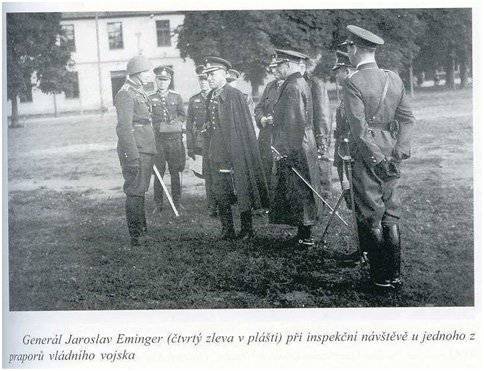 The armed forces of the tread had 12 battalions for 480-500 people each (around 7 thousand people). In addition to infantry companies in the battalions were bicycle companies and equestrian squadrons. The soldiers were armed with modernized Manlicher rifles, light and heavy machine guns, which were manufactured at the Cheska Zbroyovka factories. Heavy weapons were not. The Czech battalions were given the task of guarding communications, important facilities, carrying out engineering and rescue work, and helping police formations. The former brigadier general of the Czechoslovak army, Yaroslav Eminger, was appointed commander of the protectorate’s armed forces.
The armed forces of the tread had 12 battalions for 480-500 people each (around 7 thousand people). In addition to infantry companies in the battalions were bicycle companies and equestrian squadrons. The soldiers were armed with modernized Manlicher rifles, light and heavy machine guns, which were manufactured at the Cheska Zbroyovka factories. Heavy weapons were not. The Czech battalions were given the task of guarding communications, important facilities, carrying out engineering and rescue work, and helping police formations. The former brigadier general of the Czechoslovak army, Yaroslav Eminger, was appointed commander of the protectorate’s armed forces. In 1944, the 11 of the Czech battalions was transferred to Italy to protect communications (one battalion remained to guard the residence of President Emil Gahi in Hradcany). Soon, however, several hundred Czechs sided with the Italian partisans, and were transferred to the Czechoslovak armored brigade under the command of General Alois Lisa, who was at that time fighting in France. The German command was forced to disarm the remaining Czech soldiers and send them to engineering work.
In addition, the Czechs fought in the SS forces. At the end of May, 1942 established the “Supervision of Youth Education in Bohemia and Moravia” in the protectorate. The organization took young people aged 10 - 18 years and brought up in the spirit of National Socialism, developed physical culture. Senior members of the "Curator" had the opportunity to enter the service in the special forces of the SS, and the younger - in the "Exemplary Link." In the future, these structures were to become the core of the Bohemian SS.
In February 1945, the first set of Czechs joined the SS Brisken SS Regiment, which became part of the 31 Volunteer Grenadier SS Division Bohemia and Moravia. In the same year, about one thousand former soldiers and commanders of the Czechoslovak cavalry became part of the formed 37 Volunteer Cavalry SS division "Lutzov". At the beginning of May 1945 of the year, during the Prague Uprising, a Volunteer company of the SS "St. Wenceslas" (77 people) was formed from members of various Czech pro-fascist organizations and special forces SS fighters. The company has joined the German garrison of Prague. Part of the Czech SS, after the defeat of Germany, joined the French Foreign Legion and fought in Indochina.
Czechoslovak formations in the troops of the anti-Hitler coalition countries
Poland. After the entry of the Czech Republic into the Third German Empire, about 4 thousand commanders and soldiers of the former Czechoslovak army, as well as civilians who did not want to remain in the territory subject to Berlin, moved to the Polish state. At the end of April, the Czechoslovak Foreign Group was established 1939, which initially included about 100 people. In addition, the transfer began on the warships of the Czechoslovak military to France, where more than 1200 people moved, a third of whom were pilots.
In Poland itself, the Czechoslovak Legion (about 800 people) and the Czechoslovak reconnaissance squadron (93 people) were formed. The Legion was headed by Lieutenant General of the former Czechoslovak Army Lev Prhal, his assistant was Colonel Ludwik Svoboda. The formation of Czech units at the time of the German invasion was not completed, so they took little part in the fighting (in the battles in Galicia, 5 people were killed and 6 wounded). One part of the Czechoslovak Legion was captured near the village of Rakovets near Ternopil by units of the Red Army. The other part - about 250 people, including General Prhal, crossed the border with Romania and in different ways reached France or the French possessions in the Middle East.
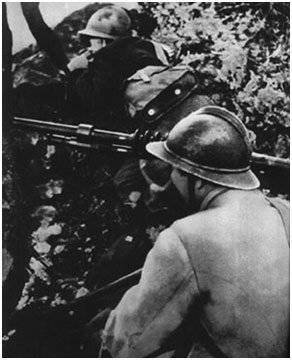 France. In late September, the French military command began to form an infantry battalion from Czechoslovakia. October 2 1939, the head of the French government, Edouard Daladier, and the Czechoslovak ambassador, Stephen of Osuis, signed an agreement on the formation of Czechoslovak troops in France. 17 November 1939 Paris officially recognized the Czechoslovak National Committee, headed by former Czechoslovak President Edward Beneš, as the legitimate government of Czechoslovakia in exile.
France. In late September, the French military command began to form an infantry battalion from Czechoslovakia. October 2 1939, the head of the French government, Edouard Daladier, and the Czechoslovak ambassador, Stephen of Osuis, signed an agreement on the formation of Czechoslovak troops in France. 17 November 1939 Paris officially recognized the Czechoslovak National Committee, headed by former Czechoslovak President Edward Beneš, as the legitimate government of Czechoslovakia in exile. From the Czechs and Slovaks living in France and arriving from Poland since the beginning of 1940, the 1st Czechoslovak Division began to be formed. Recruitment into it was both voluntary and by mobilization. The Czechoslovak division included two infantry regiments (they did not manage to equip the third regiment), an artillery regiment, a combat engineer battalion, an anti-tank battery and a communications battalion. The compound was led by General Rudolph Whist. By May 1940, there were 11405 people in the division (45% of Czechs, 44% of Slovaks, 11% of Russians, Ukrainians, and Jews). In addition, Czechs were formed in France aviation parts numbering about 1800 people.
With the beginning of active hostilities on the Franco-German front, the 1-I Czechoslovak division received the task of covering the retreat of the French troops. Czechoslovak units took part in the battles on the Marne (13 - 17 June) and Loiret (16 - 17 June). In them, the division lost only 400 people killed, 32 Czechoslovak military personnel were awarded Military crosses. 22 Jun division received orders to lay down weapon. Approximately 3 thousand division soldiers and 2 thousand Czechoslovaks from other units were shipped to the UK.
England. In addition to the Czech military, who directly crossed the English Channel, around 200 people after the surrender of Paris from French Lebanon moved to British Palestine. At the end of October, the Czechoslovak 1940 Battalion began to form the 11 of Palestine in Palestine as part of the British Army. The unit was commanded by Lieutenant Colonel Karel Klapalek. In December 1940, the unit was 800 people and the battalion was trained in the camp at Jericho.
In the spring of 1941, the 11 Battalion, together with Polish units, guarded the camp for Italian-German prisoners (it contained about 10 thousand people) near Alexandria in Egypt. In the summer, the battalion took part in battles against the troops of the French Vichy government in Syria. It is interesting that here the battalion soldiers clashed with their compatriots who served in the French Foreign Legion. Captive Czechs and Slovaks allowed to join the battalion.
In October, the battalion transferred 1941 to North Africa, where he took part in battles against the blocked Italian-German group in Tobruk. In the spring of 1942, the battalion was transferred to Western Asia and began to reorganize it into the 200 th light anti-aircraft regiment. In the summer of 1943, this regiment was transferred to England, where it was disbanded, and the personnel were included in the Czechoslovak Armored Brigade.
Czech pilots took part in the defense of the airspace of England. So, on July 12, several Czechoslovak fighter squadrons were formed in Duxford. By October 1940 31, they shot down 1941 German planes. Since December, the 56-I Czechoslovak Bomber Squadron began to take over 1943 in the Allied air raids on Germany. During these raids, 313 Czech pilots died. Czechoslovak pilots fought in the British Air Force until the end of the war in Europe. The most effective Czechoslovak pilot in the British Air Force was Captain Karel Kutgelvasher - he shot down 560 enemy aircraft. Sergeant Josef Frantisek had on his account 20 enemy aircraft, captain Alois Vasyatko - 17 aircraft, captain Frantisek Perzhina - 16 machines.
London recognized the Czechoslovak government in exile 21 July 1940, 25 in October 1940 after the joint decision of the British and Czechoslovak governments began the formation of the 1 of the Czechoslovak mixed brigade (it defended the southern English coast to the 1944 year). In 1944, the Mixed Brigade was reformed into the Czechoslovak Armored Brigade under the command of Brig. Gen. Alois Lick. 30 August 1944 brigade was landed in French Normandy and was in reserve until early October. From October 7 to the capitulation of Germany, the brigade took part in the siege of Dunkirk. During this time, the armored brigade lost 201 people killed and 461 wounded. On May 12, a joint detachment from this brigade arrived in Prague for a symbolic entry into the Czech capital.
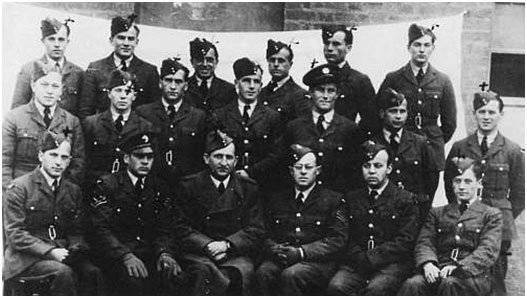
Czechoslovak pilots in England. 1943
Czechoslovak units in the Red Army
As already noted, in September 1939, the Red Army near the village of Rakovets near Ternopil captured several hundred soldiers and commanders of the Czechoslovak Legion, which was part of the Polish armed forces. They were interned in camps for Polish prisoners, first in Ukraine and then near Suzdal. In April, 1940 was sent by 1 transport to 45 legionaries according to an agreement between Moscow and Paris. During the 1940-1941. 10 parties with interned Czechs and Slovaks were sent to France and the Middle East. By June 1941, the 157 ex-legionaries remained in the internment camps in the USSR.
18 July 1941 in England, the Soviet Ambassador Ivan Maisky and the Czechoslovak Foreign Minister Jan Masaryk signed an agreement between the USSR and the Czechoslovak Government in exile on joint actions against the Third Reich. September 27 On the 1941 of the year, the Soviet government decided to call for “Soviet citizens of Czechoslovak nationality” to the Czechoslovak units on the territory of the USSR.
At the beginning of February, in the military camps of the Polish army, under the command of General Vladislav Anders, the 1942 th Czechoslovak battalion began to be formed in Buzuluk in the military camps of the Polish army. His commander was Lieutenant Colonel of the former Czechoslovak army Ludwik Svoboda. It must be said that this man had a very rich biography already before he headed the Czechoslovak units in the USSR. Born Ludwik 1 on November 25, in a peasant family in the village of Groznatin of the Austro-Hungarian Empire. He received a specialty agronomist, was drafted into the Austro-Hungarian army in 1895 year. Freedom fought on the Eastern Front against the Russians, then voluntarily surrendered to captivity. Contained in a camp near Kiev, after his release he served in the city fire brigade, in September 1915 joined the Czechoslovak Legion (commanded a platoon, company). He participated in a number of battles on the side of the Russian imperial army. After the revolution and the uprising of the Czechoslovak Corps, he took part in battles with the Red Army (commanded a company, battalion). In 1916, he returned to his homeland. From 1920, he served in the Czechoslovak army with the rank of captain. At the time of the occupation of Czechoslovakia by the Germans, he was a battalion commander. He was dismissed from the army and became a member of the anti-fascist group, after its disclosure, he fled to Poland. In the Polish state was an active participant in the creation of Czechoslovak military units as part of the Polish army. After the defeat of Poland, was captured by the Red Army, was in internment camps. He was an active supporter of the creation of a Czechoslovak military unit in the Red Army.
To replenish the 1 of the Czechoslovak battalion 3 in February 1942, the USSR State Defense Committee announced an amnesty for all citizens of Czechoslovakia. 19 November 1942 The Presidium of the Supreme Council announced an amnesty for all imprisoned Ukrainians and Slovaks from Hungary who were formerly citizens of Czechoslovakia. By January 1943, the Czechoslovak battalion had 974 people (52% were Ukrainians-Ruthenians and Jews, 48% were Czechs and Slovaks). They were armed with Soviet small arms, outfitted in British uniforms with Czechoslovak insignia.
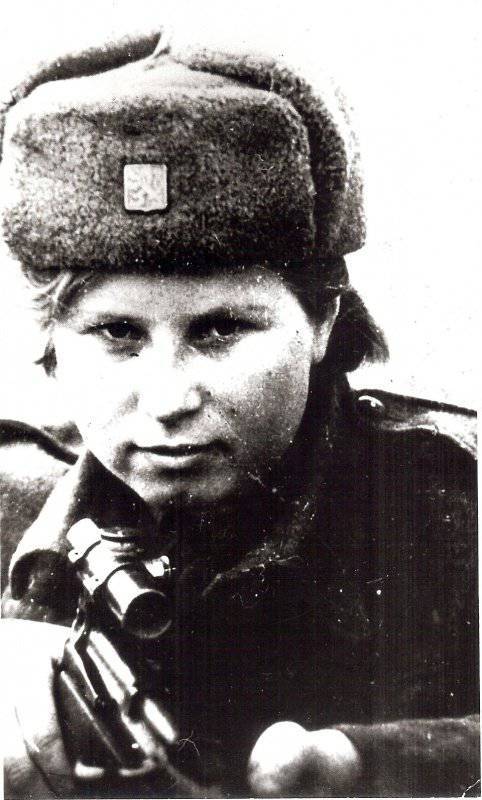
Valentina (Vanda) Binyevsk was born 27.09.1925 in the town of Uman, Cherkasy region, in a Czech family. In 1942, the city of Wanda joined the emerging 1 Czechoslovak Separate Battalion, graduated from medical instructors and snipers. She participated in the battles for Kiev and Sokolovo as an observer-sniper. In 1944, she was abandoned to the enemy's rear, in Slovakia, where she fought as part of the Slovak rebel units. 3 March 1945 was captured by the Germans in the city of Banská Bystrica, where 17 March was able to escape by joining the Stalin partisan detachment. She ended the war as a sergeant of the Czechoslovak army.
In March 1943, the battalion became part of the 3rd tank army of the Voronezh Front and for the first time joined the battle in the village of Sokolovo near Kharkov. During the Kharkov defensive operation, the battalion, together with Soviet units, repelled German attacks. In this battle, the Czechoslovak battalion suffered heavy losses (only 153 people were considered dead and 122 were missing, almost all company and platoon commanders died), but showed high morale and good training. The battalion was taken to the rear and in May in Novohopersk, the 1st Czechoslovak separate infantry brigade began to be formed at its base. In addition to the infantry battalions, the tank battalion also entered the brigade (20 tanks and 10 armored vehicles). By September 1943, there were 3517 people in the brigade (more than 60% were Rusyns, the rest were Czechs, Slovaks, Russians and Jews). The brigade was reinforced by officers who arrived from England and the Middle East.
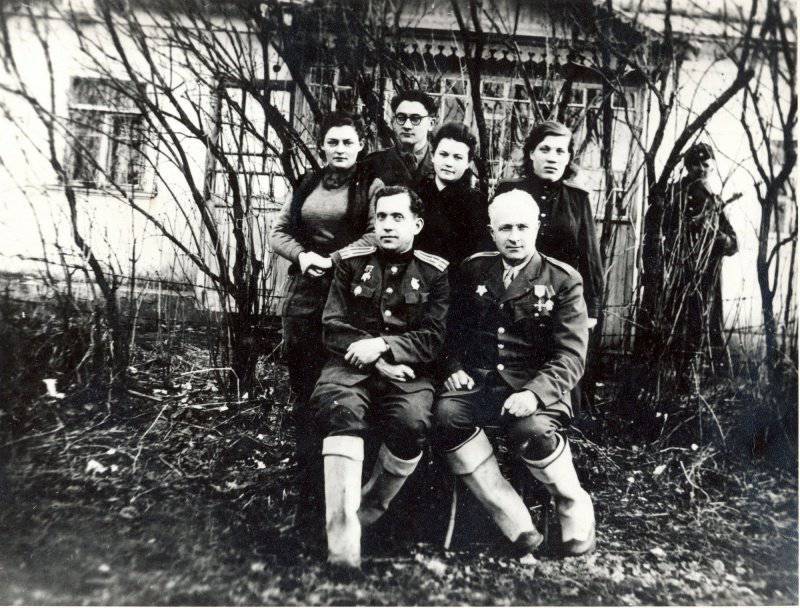
The commander of the 1 th Czechoslovak Separate Brigade, Colonel Ludwik Svoboda (sitting to the right) with his colleagues.
At the end of September 1943, the brigade was sent to the front. In November, she was part of the 1-th Ukrainian Front took part in the battles for Kiev, in the area of Vasilkova, Rudy, Belaya Tserkov and Zhashkova. During these battles, only the killed brigade lost 384 man. In the spring of 1944, the team was taken to the rear for re-formation and replenishment. On the basis of the brigade, the Czechoslovak Army Corps 1 began to be formed. It was created at the expense of the recruits of the Volyn and Prykarpatye regions liberated by the Red Army, as well as Slovak prisoners of war and Czechoslovak commanders who arrived from England. By September 1944, the Czechoslovak Corps numbered the 16 171 man. The corps consisted of three separate infantry brigades, a separate airborne brigade, a separate tank brigade (23 tank and 3 SAU, commander - staff captain Vladimir Yanko), artillery regiment, fighter aviation regiment (21 fighter, commander - headquarters Fitl), a separate engineer battalion, a separate communications battalion. The brigadier general Jan Kratochvil became commander of the corps at the suggestion of the Czechoslovak government.
In addition, from the beginning of 1944, in Efremov (Tula Region), the Czechoslovak Separate Airborne Brigade began to create the 2 th. The backbone of this was the soldiers and commanders of the 1 of the Slovak division, which moved in December 1943 under Melitopol to the side of the Red Army.
In August, the 1944 of the 1 of the Czechoslovak Army Corps as part of the 1 of the Ukrainian Front operated in the Carpathian region. In the East Carpathian operation, the corps was to assist the beginning of the Slovak uprising during the offensive of the Red Army. However, on the very first day of participation in the battle (September 9) due to weak reconnaissance organization and poor management, two brigades of the Czechoslovak Corps came under heavy fire from German artillery and suffered significant losses (611 people). Marshal of the Soviet Union I. S. Konev, with his order, replaced Kratochvil with Freedom. Czechoslovak troops continued the offensive, in fierce battles breaking through one after another the enemy's defensive positions in the mountains. On September 20, the corps liberated the city of Duklja, and on October 6, by storm, captured the well-fortified Dukla Pass, which was located on the old Czechoslovak border. On this day, Soviet and Czechoslovak troops entered Czechoslovakia, initiating its liberation from the Germans. On the same day, the landing of the 2-th Separate Airborne Brigade in Slovakia began. The paratroopers joined the rebels and engaged in heavy fighting with German troops. October 31, when the Slovak uprising was defeated, the brigade moved to the guerrilla war and was renamed the 2-th Czechoslovak partisan brigade. This brigade joined the advancing Soviet, Czechoslovak and Romanian forces 19 in February 1945 of the year.
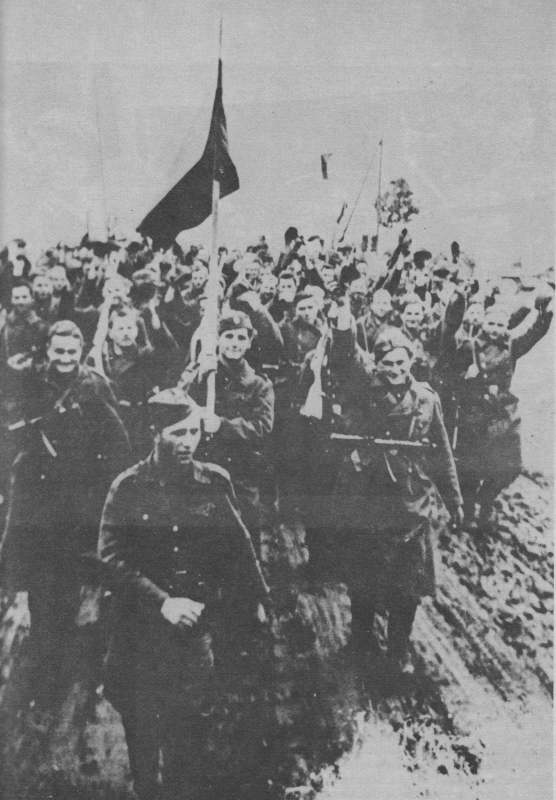
Warriors of the 1 Czechoslovak Army Corps, October 6 1944.
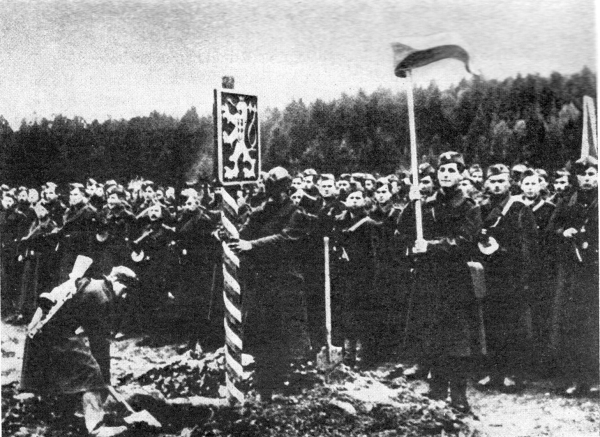
Warriors of the 1 Czechoslovak Army Corps on the state border, 1944 year.
Until November, the Czechoslovak Corps continued the offensive, then went on the defensive. The Czechoslovak units were no longer brought to the rear, acting on the front lines until the end of the war. The corps fought as part of the 38 Army of the 4 Ukrainian Front. Training of personnel and replenishment of the compounds was carried out in the reserve and training units of the corps. At the beginning of 1945, the 1 th Czechoslovak Separate Fighter Aviation Regiment was transformed into the 1 Czechoslovak Combined Aviation Division (as part of 65 aircraft) under the command of Colonel Ludwik Budin. The aviation division took an active part in the battle for Moravia.
In January 1945, the corps took part in the West Carpathian operation, in March - in the Moravian-Ostrava operation. 4 April 1945. Brigadier General Karel Klapalek was appointed commander of the formation. 30 On April, the Czechoslovak Corps entered the Czech Republic itself and continued to stubborn battles with German troops until Germany surrendered. 10 May 1945, the advanced corps units on Soviet tanks entered Prague. The losses of the Czechoslovak Corps, together with the losses of a separate battalion and a separate brigade, in 1943 — 1944. 4 made 011 people dead, missing and dead from injuries and 14 202 people - sanitary.
17 on May 1945, a parade of the entire Czechoslovak Corps was held in Prague: at the same time, along with the rear and training units, its number was 31 725 people. Since June, the 1945 Army of the Czechoslovak People's Army began to form the 1 on the basis of the corps.
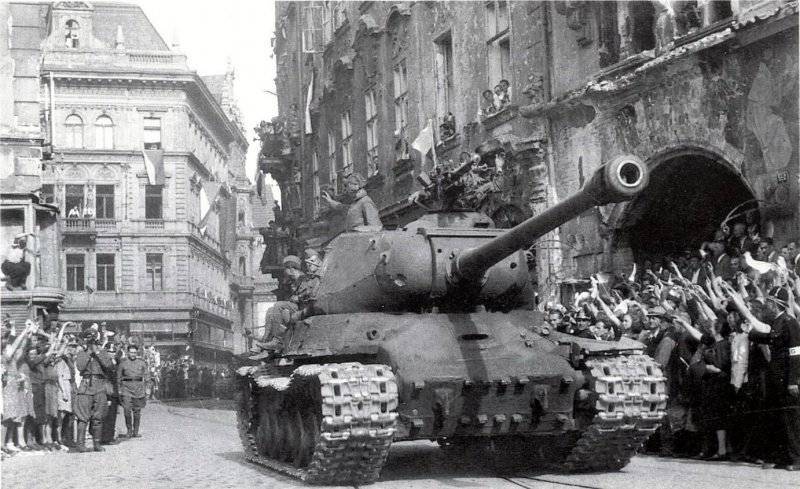
Tank EC-2 1 of the Czechoslovak Czechoslovak Army Corps in the center of Prague.
Information